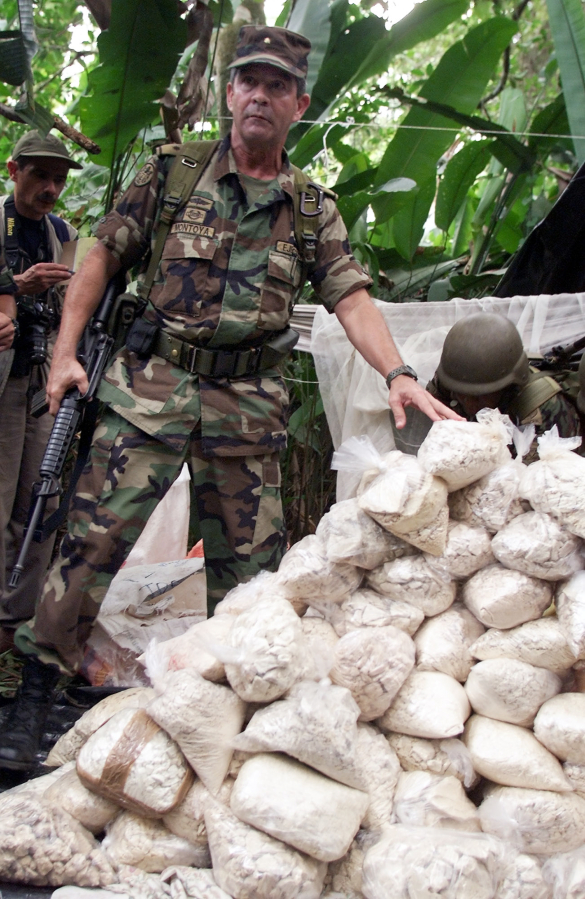American taxpayers got a dismal return on their $4.3 billion investment in the Colombian drug war between 2000 and 2008, according to a new analysis by economists at MIT and Colombia’s Universidad de los Andes.
In the paper, in the June issue of the Journal of Economic Behavior and Organization, Daniel Mejia and Pascual Restrepo analyzed the cost to U.S. taxpayers of the two big U.S.-funded anti-cocaine efforts in Colombia: eradication of coca plants via the aerial spraying of pesticides, and interdiction efforts to block cocaine transit routes and seize shipments of cocaine. These efforts took place under the umbrella of Plan Colombia, a decadelong U.S.-backed initiative to fight the drug trade and organized crime in Colombia.
Mejia and Restrepo created a sophisticated economic model to account for the costs and benefits of these efforts. The model describes the international cocaine trade in its entirety, from production to transportation to sale. And it considers the tactics that coca growers and drug traffickers use to respond to enforcement efforts, like increasing production and shifting trade routes.
Mejia and Restrepo found that between 2000 and 2008, it cost the U.S. government $940,000 to eliminate a single kilogram of cocaine from the domestic market via pesticide spraying in Colombia. Eliminating that kilo via interdiction was considerably cheaper, at $175,000.
Why is interdiction so much more cost-effective than eradication? One reason is that cocaine’s raw material — the coca plants targeted by eradication — make up a fairly tiny fraction of the final product’s overall cost. For instance, the farm gate price of raw coca leaves is as little as $4.30 per kilogram in neighboring Peru. But by the time refined cocaine reaches the U.S. market, it sells for as much as $27,000 per kilogram or more.
Much of that additional cost gets added on in refinement and trafficking, as various middlemen take their cut. If you’re trying to stop cocaine from entering the U.S., seizing a parcel of it at a border somewhere will take a much bigger bite out of the overall flow than spraying a farmer’s field.
But according to Mejia and Restrepo, both interdiction and eradication were far more expensive than reducing cocaine consumption via other means. Eliminating a kilogram of cocaine consumption via drug treatment strategies (e.g., helping people stop using cocaine) would cost between $12,500 and $68,705 per year, according to a separate 2001 analysis cited by Mejia and Restrepo.
“Our numerical exercise suggests that interventions such as Plan Colombia are inefficient and socially costly ways of reducing drug consumption,” Mejia and Restrepo conclude.
Their analysis doesn’t consider the Colombian government’s share of anti-cocaine spending on the program. Nor do these dollar figures reflect the steep social costs of anti-drug efforts in Colombia: Environmental devastation wrought by spraying millions of acres of jungle with herbicide. Public health concerns. The inherent violence of sending militarized police to fight drug traffickers.
On top of all this, the program appears to have had little tangible impact on day-to-day cocaine use patterns in the U.S. Between 2000 and 2008, the price per gram of cocaine purchased in the U.S. actually fell slightly, from $205.67 to $182.75, according to the Office of National Drug Control Policy — not what you’d expect if there were a shortage of supply. And federal survey data show that cocaine use patterns were essentially flat over the same period. Percentage-wise, just as many people used cocaine in 2008 as in 2002.
One possible explanation for this, identified by Mejia and Restrepo: Cocaine growers simply became more efficient in response to eradication efforts. They significantly increased their crop yields via better growing and farming practices, “from roughly 4.3 kg of cocaine per hectare per year prior to 2000, to about 6.6 kg of cocaine per hectare per year in 2008.” And as enforcement efforts intensified in Colombia, other countries like Peru and Bolivia simply took up some of the slack in cocaine production.
This doesn’t necessarily mean that Plan Colombia had no impact on cocaine consumption in the U.S. — after all, it’s possible that rates of cocaine use would have increased if the Plan weren’t in operation, or that cocaine prices would have fallen even further. And there are the social costs of cocaine use to consider as well.
Jonathan Caulkins, a drug policy expert at Carnegie Mellon University, points out that the estimated price of eradicating a kilogram of cocaine via interdiction efforts ($175,000) may not be a bad bargain when you consider the total social costs of cocaine use — harm to the user, harm to the people around the user, costs relating to enforcement, etc.
Caulkins has estimated the average social cost of a gram of cocaine consumed in the U.S. to be about $215, which is equivalent to $215,000 in social cost per kilogram of cocaine. That is more than the $175,000 that Meija and Restrepo estimate that it costs to remove that kilo from society via interdiction in Colombia.
“That’s not cheap,” he said in an email, “but again, I don’t know if it is a crazy bad buy. That depends on your values.”
But again, Mejia and Restrepo’s calculations show that these efforts are considerably less cost-efficient than other interventions, like helping addicts quit or keeping them from using in the first place.
“If the U.S. wants to reduce drug consumption, it is better off investing in treatment and prevention programs domestically than subsidizing source country interventions, (such) as Plan Colombia, abroad,” they conclude.



